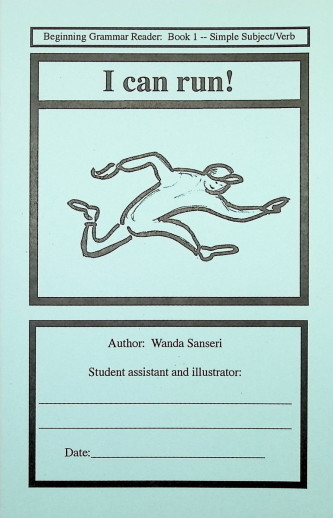We use cookies to make your experience better. To comply with the new e-Privacy directive, we need to ask for your consent to set the cookies. Learn more.
I Can Run! Beginning Grammar Reader (Spell to Write & Read)
Each page in I Can Run! has a sentence or two made up of early words taught in WISE Guide. The student reads the sentence and then draws a picture to show that he understands the meaning. Next the student is gently exposed to a basic grammar concept. In book one, the teacher is given questions to guide the child to find the simple subject and verb. A line is provided where the student can write these words as directed. A vertical line bisects it.
One page, for example, has the sentence, "We go up the hill by Jill." The teacher asks, "Who goes?" The student answers, "we." The teacher says, "Write the subject 'we' before the dividing line." Next the teacher asks, "What do we do?" The student answers "go." The teachers says, "Write the verb, go, after the dividing line."
This exercise gives the child a mental framework to understand the idea of a complete sentence. Personal pronouns (I, you, he, she, it, we) are used as the subject throughout the book. This prepares the student for changing the verb after the third person pronouns (he, she, it). On the last page the student can read subject verb combinations with all thirteen verbs covered in the book. Example: I run. You run. He runs. We run.
Programs in this section go beyond teaching children how to read, incorporating phonetic readers, spelling and writing as well. Arranged roughly by grade/age.
What do The Writing Road to Reading, and this program, Spell to Write & Read have in common? Both have similar (and potentially confusing) names. Both would be labeled intensive phonics. And Both would claim a teaching progression something like this: sounds of speech - building words - developing a spelling vocabulary - writing original sentences - and then reading follows. If that sounds a little backwards to you, remember that these programs have very devoted followers who claim great success using this methodology and Spell to Write and Read is one of Cathy Duffy's 100 Top Picks for Homeschooling Curriculum.
Spell to Write and Read by Wanda Sanseri is an updated replacement for a previous program (Teaching Reading at Home and School) and is designed exclusively to work with the W.I.S.E. Guide for Spelling, also by Mrs. Sanseri. While SWR and the WISE Guide are considered a reading and spelling program, they could also be used as a stand-alone spelling program for a child who is already reading. SWR functions as a step-by-step teacher's guide to accompany the specific word lists in the WISE Guide. Covering preparation, philosophy, preschool pointers, reading aloud, evaluating achievement levels, and teaching penmanship with phonograms, it also illustrates in scripted detail the spelling dictation process and the spelling rule Reference Pages with instructions and examples. These spelling rule Reference Pages are central to the entire teaching/learning system. Ideas for reading assignments, ways to improve comprehension skills and refine composition skills round out the teacher's tools. In summary, this is the overall master book of a product combination that works together to teach the first four to five years of language arts or to remediate students of any age. The other components include the WISE Guide, 70 Basic Phonogram Cards, Spelling Rule Cards, 70 Basic Phonograms CD, the Primary Learning Log, and the Black Learning Log (more details on these below).
The W.I.S.E. Guide for Spelling (W.I.S.E. stands for Words, Instruction, and Spelling Enrichments) includes a core spelling list that is an updated version of the well-known Ayres List - a foundational vocabulary of 2000 spelling words. Words are divided into manageable daily lessons with 2 pages of teaching ideas for each set of 20 words. Each lesson has preliminary warm-up drills, motivational comments for introducing the lesson, and reminders to teach specific Reference Pages from SWR. Sample sentences are given to illustrate each word. Selections come from the Bible, literature, quotes from famous people, or instructive comments. Each word is divided into syllables and marked for spelling rules. Suggested teacher dialogue is provided. Optional enrichment activities involve a wide variety of subjects - art, literature, composition, grammar, etymology, alphabetizing, analogies, oxymorons, and many more.
This program, like other intensive phonics programs, is exceedingly detailed and painstakingly comprehensive and thorough. The extreme attention to detail would detract for many, but for those who want to follow a thoroughly researched and carefully implemented approach, this may be for you. ~ Janice
| Product Format: | Paperback |
|---|---|
| Brand: | Back Home Industries |
| Grades: | 1-2 |
| ISBN: | 9781880045350 |
| Length in Inches: | 8.5 |
| Width in Inches: | 5.375 |
| Height in Inches: | 0.0625 |
| Weight in Pounds: | 0.1 |

